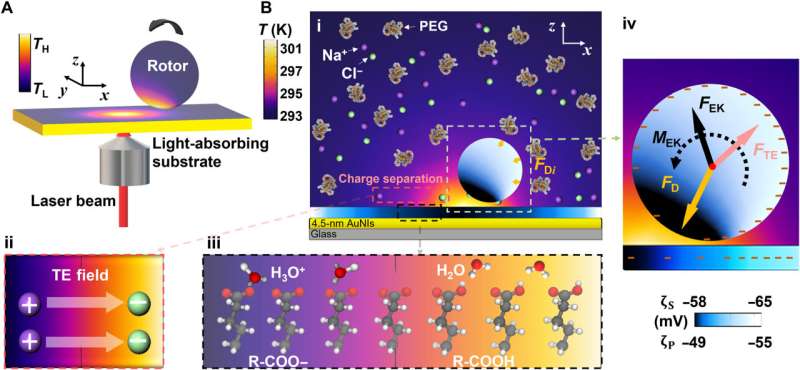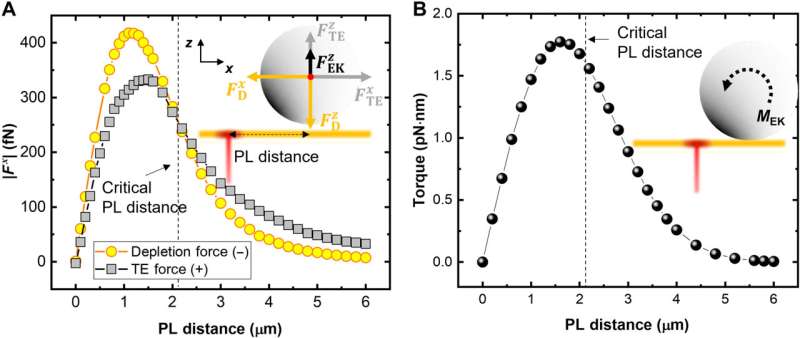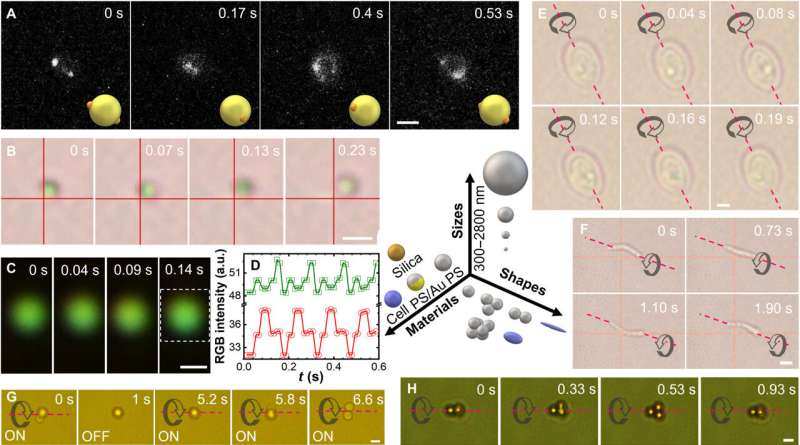July 1, 2022 feature
Universal optothermal micro/nanoscale rotors

The fundamental rotation of micro and nano-objects is crucial for the functionality of micro and nanorobotics, as well as three-dimensional imaging and lab-on-a-chip systems. These optical rotation methods can function fuel-free and remotely, and are therefore better suited for experiments, while current methods require laser beams with designed intensity profiles or objects with sophisticated shapes. These requirements are challenging for simpler optical setups with light-driven rotation of a variety of objects, including biological cells.
In a new report now published in Science Advances, Hongru Ding and a research team in engineering and materials science at the University of Texas at Austin, U.S., developed a universal approach for the out-of-plane rotation of various objects based on an arbitrary low-power laser beam. The scientists positioned the laser source away from the objects to reduce optical damage from direct illumination and combined the rotation mechanism via optothermal coupling with rigorous experiments, coupled to multiscale simulations. The general applicability and biocompatibility of the universal light-driven rotation platform is instrumental for a range of engineering and scientific applications.
Opto-thermoelectric rotation
By regulating the rotation of micro- and nanoscale objects, researchers have proven effective functionalities across precise nano surgery, vacuum friction and microfluidic flow control. Light-driven micro- and nanorotors are a promising fuel-free option, although such devices have remained challenging to build on because they need simpler and low-power optics to achieve light-driven rotation. Ding et al proposed opto-thermoelectric rotation (OTER) in this new work, to generate electrokinetic force, depletion force and electric force based on simple and low-power optics.
The research team achieved the rotation of spherically symmetric and homogenous micro and nanoparticles via a single Gaussian laser beam positioned away from the rotors, to reduce the damage caused by direct light illumination. By combining the experiments with multiscale simulations they revealed optothermal rotation via electrokinetic interactions between micro- and nanoparticles, and the substrate with thermo-responsive surface charge. As proof of concept, the team showed how the OTER strategy could rotate objects of different sizes, materials and shapes to regulate the incident light and surface chemistry.

Mechanism of action of universal light-driven rotors
The researchers illustrated the experimental setup and working mechanism of OTER—where a laser beam generated optothermal forces on the particles. Ding et al tailored the net force and torque via the laser power and laser particle distance for out-of-plane rotation of the micro and nano-objects. They then directed the laser beam to a light-absorbing substrate such as a porous gold film to establish a tailorable temperature field in microseconds.
In order to optothermally generate the forces and torque required for stable rotor rotation, Ding et al added polyethylene glycol (PEG) molecules, and phosphate buffered saline into water and functionalized the substrate with carboxylic acid–terminated alkanethiol monolayers. Upon laser illumination, the team achieved a temperature rise to create a thermoelectric field in the presence of ions to drive thermo-electrophoresis of the charged rotor. They explored the surface charge gradient on the substrate to then provide an optothermally tunable electrokinetic force known as the thermoelectric force.

Characterizing and modeling opto-thermoelectric rotation
Ding et al studied the rotation behavior of light-driven rotors by using optical microscopy. They acquired better examination of rotation behavior by labeling a polystyrene microparticle with two fluorescent nano-beads with streptavidin-biotin binding for the out-of-plane rotation of the particle driven by a laser. The observed off-axis rotation protected the delicate rotors, including live cells from damage caused by high power optical illumination. The team further incorporated finite element analysis, molecular dynamics, and finite difference time domain simulations to analyze the working forces of opto-thermoelectric rotors. The scientists calculated the opto-thermal forces and torques acting on the rotor as a function of particle-laser distance and conducted a series of experiments and simulations to understand the impact of electrokinetic force, depletion force and thermoelectric force by tuning the surface charge of the substrate and components of the solution.

Applications of OTER
Ding et al showed the impact of OTER on biological cells and synthetic particles of diverse materials, sizes and shapes. They displayed the rotation of nanoscale rotors such as polystyrene-gold Janus particles by using dark-field optical microscopy. The OTER method is also applicable to live cells including live strains of fungi, bacteria and even human cells in cell culture media containing ions. Additionally, the method is suited for rotors with complex architectures including out-of-plane rotation of particle dimers, trimers, and hexamers. Using the method, Ding et al envision accurate regulation of the rotor and laser beam to accomplish 3D profiling of biological cells and synthetic particles of high resolution.
Outlook
In this way, Hongru Ding and colleagues harnessed thermo-diffusion of ions and molecules in solutions to develop a thermoresponsive charge at solid-liquid interfaces. The opto-thermoelectric strategy allowed the rotation of micro- and nanoscale objects in a liquid environment with simple and low-power optics. The method is superior to existing conventional techniques with universal applicability for image sensing and biomedical applications. The team expect the optothermal approach to play a significant role in in vitro biological studies to rotate cells and synthetic particles in native biofluids with ions and biomolecules.
More information: Hongru Ding et al, Universal optothermal micro/nanoscale rotors, Science Advances (2022). DOI: 10.1126/sciadv.abn8498
Jonghoon Ahn et al, Ultrasensitive torque detection with an optically levitated nanorotor, Nature Nanotechnology (2020). DOI: 10.1038/s41565-019-0605-9
Journal information: Nature Nanotechnology , Science Advances
© 2022 Science X Network




















